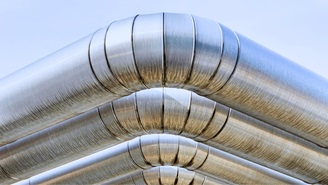Key Insights:
- REEs and PGMs are highly concentrated according to geography, which increases ESG risks due to automobile companies’ reliance on them. In 2022, China accounted for approximately 70% of total REE mine production worldwide.
- A best practice for eco-design that automakers can implement is LCAs, which evaluate the environmental impacts of a vehicle across its lifespan. Morningstar Sustainalytics research shows that such practices are adopted mostly by large-cap companies in the industry, which suggests that the largest automakers have the necessary resources to invest in establishing strong management programs.
As automakers produce more cars, they become increasingly dependent on various raw materials, including rare earth elements (REEs), platinum group metals (PGMs) and chromium. The increased demand for these materials exposes companies in the industry to risks from supply disruptions and from the environmental impacts related to their use.
As part of Morningstar Sustainalytics’ enhancements to the ESG Risk Ratings, Raw Materials Use has been added as a new material ESG issue (MEI). For the automobiles industry, this new MEI will not only help capture and evaluate related risks, but also assess the specific management strategies automakers are adopting to mitigate them. In this article, we look at the key raw material risks that the automobiles industry is facing and how the enhancement to our ESG Risk Ratings provides a more comprehensive assessment of the issue.
Vehicle Demand in Lockstep with Raw Materials Demand
In 2023, passenger car sales exceeded 69 million units worldwide, representing an increase of almost 8% compared to 2022.1 Sales are expected to grow further in the coming years,2 particularly in the industry’s main markets, such as the U.S.3 Similarly, the electric vehicle (EV) market continues to grow, as the automobiles industry targets a rapid transition toward electrification.
Companies in the industry are also working to align with increasingly stringent regulations in some of their main markets, including a ban on the sale of conventional internal combustion engine (ICE) vehicles by 2035 in the European Union.4 According to the International Energy Agency (IEA), in 2023, sales of battery electric vehicles (BEVs) and plug-in hybrid electric vehicles (PHEVs) increased by 35% compared to 2022, reaching almost 14 million cars, a number that is expected to grow to 17 million cars in 2024.5
This growth in vehicle sales generated an increase in the demand for raw materials used in EVs, such as lithium, cobalt, and nickel, leading many automakers to invest directly in the mining sector.6,7 PGMs, such as platinum and palladium, which are used in catalytic converters for ICE vehicles, also remain important, as they help to convert pollutants into less harmful emissions and water vapor. Platinum is also an essential material. It acts as a catalyst in fuel cell electric vehicles (FCEVs), which can use as much as double the amount of platinum compared to a conventional ICE vehicle.8
Most EVs also rely on electric motors that use permanent magnets made with REEs because they improve energy efficiency and, consequently, extend driving ranges. This makes REEs such as neodymium, praseodymium and dysprosium critical components of electrical motors. In all, the value of imports of PGMs and REEs, among other materials, almost doubled between 2017 and 2022, according to the World Trade Organization.9 With the industry transitioning towards zero-emission vehicles, automakers are expected to become increasingly reliant on them. The IEA forecasts that 40% of total demand for REEs by 2040 will come from clean energy technologies, including demand from automakers to produce EVs.10
As is the case with the other materials covered above, the increase in vehicle sales is also expected to drive up demand for chromium, which is forecast to become a USD 2.3 billion market by 2028.11 Chromium is widely used in the industry, primarily in its alloy form. It is added to various metal components in vehicles, as it contributes to their durability and resistance to corrosion, among other properties.
Geographical Concentration, Price Volatility and Environmental Impact
The increase in vehicle demand has also highlighted China’s dominance in the battery supply chain. REEs and PGMs are highly concentrated according to geography, which increases ESG risks, due to automobile companies’ reliance on them. As shown in Figure 1, in 2022, China accounted for approximately 70% of total REE mine production worldwide.12
Figure 1. World Mine Production of REEs by Country, 2022

Source: Natural Resources Canada, World REE mine production
Similarly, the production of PGMs is highly concentrated in a few countries, with South Africa and Russia accounting for approximately 83% of total mine production in 2022.13 This reliance on a small number of countries enhances risks of potential supply shortages. Geopolitical tensions, for instance, may also negatively impact the trade of raw materials, further limiting access to PGMs and REEs for some auto companies.
Price volatility and disruption in the supply of these materials can generate significant costs for automakers and affect production. REEs have experienced price volatility in recent years, including a price peak in 2022. The volatility was primarily due to increased demand from the EV and renewable energy sectors, combined with supply disruptions during pandemic lockdowns, and China’s low REE imports after it closed its border with Myanmar.14 Although REE prices have decreased since 2023, concerns regarding potential supply issues in China continue to cause price fluctuations15 and have led automakers to look for alternatives to reduce production costs.
As for environmental impacts, chromium use, especially hexavalent chromium used in the plating process for vehicle components, has been connected to risks of soil and groundwater contamination. The European Union has taken steps to address some of these concerns by banning hexavalent chromium use in the production of car parts, including chrome plating, by the end of 2024.16 A similar ban has also been adopted in California, but will enter into force gradually between 2027 and 2039.17 These restrictions may lead to additional R&D costs for automakers that must comply by designing vehicles with fewer or no chrome-plated components, and finding alternative materials with similar properties.
Managing the Entire Lifecycle of Vehicles
Automakers have already started addressing risks related to the use of raw materials by adopting programs and practices from the circular economy. The industry is now focused on reducing raw material use and increasing the use of recycled materials, as well as adopting efficient end-of-life programs for their cars.
With the transition to EVs, many carmakers are looking into methods to reduce the amount of REEs in electric motors. For instance, Tesla reported that it has already decreased REE usage by 25% per vehicle, while BMW no longer uses rare earth permanent magnets.18 Companies are also focused on increasing the use of recycled materials, though this remains an area in which they need to invest further. For example, Renault reports that 85% of its vehicles are recyclable, but less than 30% of recycled materials are incorporated back into the production of new cars.19
Companies also need to integrate environmental considerations during the design stage. One best practice for eco-design that automakers can implement is lifecycle assessments (LCAs), which evaluate the environmental impacts of a vehicle across its lifespan. The majority of auto companies we evaluate (excluding recreational vehicle manufactures) conduct LCAs for their product portfolio.
Our data shows that such practices are adopted mostly by large-cap companies in the industry (see Figure 2). This suggests that the largest automakers have the necessary resources to invest in establishing strong management programs – and that they are already addressing various risks at the design and production levels, including reducing the use of critical raw materials and maximizing the use of recycled materials. On the other hand, it also shows that there is still room for improvement in eco-design strategies across the industry, as some companies, regardless of their market cap, have yet to conduct LCAs.
Figure 2. Lifecycle Assessment Implementation Across Automobile Companies by Market Cap

Source: Morningstar Sustainalytics. For informational purposes only.
LCA implementation is one of the criteria evaluated in assessing companies’ program related to eco-design. This in turn contributes to a company’s score for the Raw Materials Use MEI that we have integrated into the ESG Risk Ratings. The addition of this MEI enhances our assessment of automobiles companies’ exposure and management of risks related to raw materials use. Our assessment is also strengthened by the introduction of additional indicators for this MEI that evaluate automakers’ management practices in terms of increasing use of recycled materials, raw material innovation and end-of-life product stewardship.
The new MEI will help capture more insights into companies’ preparedness to mitigate operational and financial risks resulting from their increased dependence on critical raw materials. Automobiles companies that implement systematic eco-design strategies for their vehicles and adopt practices targeting a reduction of raw material usage as well as increased use of recycled materials are better positioned to reduce such risks.
References
- Statista. 2024. “Passenger Cars – Worldwide| Statista Market Forecast.” accessed May 14, 2024. https://www.statista.com/outlook/mmo/passenger-cars/worldwide
- Ibid
- Whiston, D. 2024. “The Chip Shortage Is Mostly Over, but the Auto Industry Hasn’t Fully Recovered.” March 7, 2024. Morningstar. https://www.morningstar.com/stocks/chip-shortage-is-mostly-over-auto-industry-still-hasnt-fully-recovered
- Council of the EU. 2023. “‘Fit for 55’: Council adopts regulation on CO2 emissions for new cars and vans.” March 28, 2023. Council of the European Union. https://www.consilium.europa.eu/en/press/press-releases/2023/03/28/fit-for-55-council-adopts-regulation-on-co2-emissions-for-new-cars-and-vans/
- International Energy Agency. 2024. Global EV Outlook 2024. https://iea.blob.core.windows.net/assets/a9e3544b-0b12-4e15-b407-65f5c8ce1b5f/GlobalEVOutlook2024.pdf
- Home, A. 2023. “Automakers rush in where miners fear to tread.” March 6, 2023. Reuters. https://www.reuters.com/markets/commodities/automakers-rush-where-miners-fear-tread-2023-03-03/
- Lakshmi, A.A. & Dempsey, H. 2024. “Stellantis in talks with Vale to invest in Indonesian nickel smelter.” May 13, 2024. Financial Times. https://www.ft.com/content/ee9800d1-545c-4766-957f-1757541c2063
- Anglo American Platinum. “Fuel cell electric vehicles Driving a sustainable future.” accessed May 13, 2024. https://www.angloamericanplatinum.com/products-services-and-development/fuel-cell-electric-vehicles
- Snoussi- Mimouni, M. & Avérous, S. 2024. “High demand for energy-related critical minerals creates supply chain pressures.” January 10,2024. World Trade Organization Blog. https://www.wto.org/english/blogs_e/data_blog_e/blog_dta_10jan24_e.htm#:~:text=Critical%20minerals%20are%20particularly%20in,lithium%2C%20nickel%20and%20rare%20earths.
- International Energy Agency. 2022. The Role of Critical Minerals in Clean Energy World Energy Outlook Special Report. Transitions https://iea.blob.core.windows.net/assets/ffd2a83b-8c30-4e9d-980a-52b6d9a86fdc/TheRoleofCriticalMineralsinCleanEnergyTransitions.pdf
- PR Newswire. 2023. “Chromium's Crucial Role in Automotive Industry: Enhancing Aesthetics and Durability.” October 6, 2023. Yahoo Finance. https://finance.yahoo.com/news/chromiums-crucial-role-automotive-industry-004500719.html
- Natural Resources Canada. 2024. “Rare earth elements facts.” March 15, 2024. Natural Resources Canada. https://natural-resources.canada.ca/our-natural-resources/minerals-mining/mining-data-statistics-and-analysis/minerals-metals-facts/rare-earth-elements-facts/20522
- Natural Resources Canada. 2024. “Platinum facts.” March 15, 2024. Natural Resources Canada. https://natural-resources.canada.ca/our-natural-resources/minerals-mining/mining-data-statistics-and-analysis/minerals-metals-facts/platinum-facts/20520
- Shanghai Metals Market. 2022. “Closed China-Myanmar Border Continued to Influence China's Rare Earths Imports.” May 5, 2022. Shanghai Metals Market https://news.metal.com/newscontent/101821681/closed-china-myanmar-border-continued-to-influence-chinas-rare-earths-imports
- Editor OilPrice.com. 2024. “Rare Earths Prices Stabilize After 6 Months of Drops.” June 5, 2024. Yahoo Finance. https://nz.finance.yahoo.com/news/rare-earths-prices-stabilize-6-200000308.html
- Ensor, J. 2024. “EU ban will affect car and motorcycle colour.” February 23, 2024. Euro Weekly News https://euroweeklynews.com/2024/02/23/eu-ban-will-affect-car-and-motorcycle-colour/
- California Air Resources Board. 2023. “CARB passes new amendments to phase out toxic hexavalent chromium.” May 25, 2023. https://ww2.arb.ca.gov/news/carb-passes-new-amendments-phase-out-toxic-hexavalent-chromium
- Reuters. 2023. “The automakers and suppliers pushing to cut rare earths from EVs.” November 14, 2023. Reuters. https://www.reuters.com/business/autos-transportation/automakers-suppliers-pushing-cut-rare-earths-evs-2023-11-14/
- Renault. “Environment - circular economy.” accessed May 14, 2024. https://www.renaultgroup.com/en/our-commitments/environment-circular-economy/#:~:text=A%20vehicle%20is%2085%25%20recyclable,the%20production%20of%20new%20vehicles.
Recent Content
DEI Rollbacks: Impact on ESG Risk Ratings and Broader Implications for Investors
This article covers how not all reported rollbacks in diversity, equity, and inclusion (DEI) initiatives will have the same impact. Due to the relatively low weight of DEI in Sustainalytics’ ESG Risk Rating, we do not anticipate significant changes to overall ratings.
Industrial-Scale Decarbonization in the EU: Stewardship Field Notes From Germany, France and Spain
This article covers how Morningstar Sustainalytics’ Stewardship Team embarked on a field trip in November 2024 to learn how EU industry leaders are navigating the complex challenges of the energy transition.







